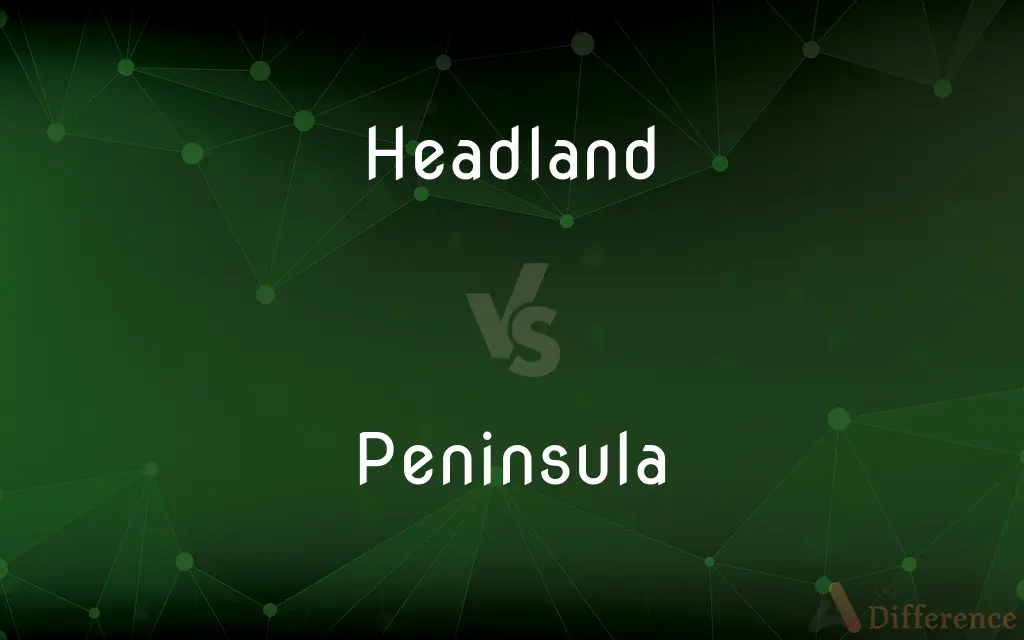Headland vs. Peninsula — What's the Difference?
By Maham Liaqat & Urooj Arif — Updated on April 3, 2024
A headland is a narrow piece of land projecting into a body of water, often characterized by high cliffs, while a peninsula is a landform surrounded by water on three sides, connected to a larger landmass on the fourth.

Difference Between Headland and Peninsula
Table of Contents
ADVERTISEMENT
Key Differences
Headlands are coastal features that extend into bodies of water, typically the sea, and are often formed by erosion processes that create cliffs and steep landscapes. They are prominent points of land that interrupt the coastline, providing dramatic scenery and acting as natural barriers against the sea. On the other hand, peninsulas are larger land formations that stretch out into bodies of water, being surrounded by water on three sides but still connected to a main body of land. Peninsulas can vary greatly in size and shape, from small spits of land barely connected to the mainland, to large expanses of land like the Florida Peninsula.
The formation of headlands is primarily due to the differential erosion of rock types along coastlines, where harder rock resists erosion better than surrounding softer rocks, eventually sticking out into the sea. Peninsulas, however, can be formed by a variety of geological processes, including the movement of tectonic plates, sediment deposition, and the rising and falling of sea levels, leading to their diverse shapes and sizes.
Headlands, due to their exposed position, face heavy erosion from waves and wind, which can lead to the creation of unique coastal features like sea caves, arches, and stacks. Peninsulas may also experience erosion, especially along their coastlines, but their larger size often includes a variety of landscapes, from flat beaches to rolling hills and even mountains, making them more versatile in terms of use and habitation.
While headlands are typically uninhabited or sparsely populated due to their rugged terrain and exposure to the elements, peninsulas often support diverse ecosystems and human settlements. The water surrounding three sides of a peninsula can moderate temperatures, making these areas more conducive to agriculture, tourism, and residential development.
Despite their differences, both headlands and peninsulas play significant roles in coastal ecology, offering habitats for various plant and animal species, and affecting local weather patterns by influencing sea currents and wind flows. They are also crucial for human activity, providing strategic locations for ports, lighthouses, and scenic viewpoints.
ADVERTISEMENT
Comparison Chart
Definition
Narrow land projecting into water, often with cliffs
Land surrounded by water on three sides
Formation
Erosion of coastline, creating steep landscapes
Various, including tectonic movements and sediment deposition
Size and Shape
Typically smaller and more pointed
Can range from small to very large expanses
Erosion
High due to exposure to elements
Varies, but generally less than headlands
Human Habitation
Less common due to rugged terrain
Often supports settlements and agriculture
Compare with Definitions
Headland
A coastal projection with cliffs, formed by erosion.
The headland offered stunning views of the ocean.
Peninsula
Formed by geological and sea-level changes.
Tectonic activity helped shape the long peninsula.
Headland
Characterized by its steep and high terrain.
Birds nested along the inaccessible cliffs of the headland.
Peninsula
Land surrounded by water on three sides.
The peninsula was a popular vacation spot due to its beaches.
Headland
A point of land jutting into the sea, resisting erosion.
The lighthouse stood atop the rugged headland.
Peninsula
Larger than a headland, with varied landscapes.
The peninsula featured both mountains and fertile plains.
Headland
Prone to wave erosion, creating distinct features.
Sea arches and stacks dotted the coastline near the headland.
Peninsula
Moderate climate due to surrounding water.
The peninsula enjoyed mild weather year-round, attracting tourists.
Headland
Less suitable for human habitation.
Few houses can be found on the harsh landscape of the headland.
Peninsula
Supports diverse ecosystems and human activity.
The peninsula’s coast was dotted with fishing villages.
Headland
A headland, also known as a head, is a coastal landform, a point of land usually high and often with a sheer drop, that extends into a body of water. It is a type of promontory.
Peninsula
A peninsula (Latin: paeninsula from paene 'almost' and insula 'island') is a landform surrounded by water on most of its border while being connected to a mainland from which it extends. The surrounding water is usually understood to be continuous, though not necessarily named as a single body of water.
Headland
A point of land, usually high and with a sheer drop, extending out into a body of water; a promontory.
Peninsula
A piece of land almost surrounded by water or projecting out into a body of water.
Headland
The unplowed land at the end of a plowed furrow.
Peninsula
A piece of land that juts out from a larger land mass and is mostly surrounded by water.
Headland
Coastal land that juts into the sea.
Peninsula
(geography) A piece of land projecting into water from a larger land mass.
Headland
The unplowed boundary of a field.
Peninsula
A portion of land nearly surrounded by water, and connected with a larger body by a neck, or isthmus.
Headland
A cape; a promontory; a point of land projecting into the sea or other expanse of water.
Peninsula
A large mass of land projecting into a body of water
Headland
A ridge or strip of unplowed at the ends of furrows, or near a fence.
Headland
A natural elevation (especially a rocky one that juts out into the sea)
Common Curiosities
What distinguishes a headland from a peninsula?
A headland is a narrow, cliff-lined projection into water, while a peninsula is a larger landform surrounded by water on three sides.
Do headlands always have cliffs?
While many headlands are characterized by cliffs due to erosion, not all headlands have steep cliffs.
Why are peninsulas more habitable than headlands?
Peninsulas often have a milder climate and more varied landscapes, making them more suitable for settlements and agriculture.
What role do headlands and peninsulas play in coastal ecosystems?
They provide unique habitats for wildlife and affect local weather and sea currents, influencing biodiversity.
How are headlands formed?
Headlands are formed by the erosion of the coastline, where harder rock erodes slower than surrounding material.
Are all headlands surrounded by water?
Headlands project into bodies of water but are connected to the mainland, not surrounded by water on all sides.
Can the size of a peninsula affect its climate?
Yes, the size and geographical orientation of a peninsula can significantly influence its climate, especially in terms of temperature and precipitation patterns.
How does erosion affect the shape of peninsulas and headlands over time?
Erosion can gradually alter the shape of both, potentially making headlands more pronounced or changing the coastline of peninsulas.
Can a peninsula be formed by human activities?
Yes, human activities like dredging and land reclamation can contribute to the formation or expansion of peninsulas.
What are some examples of famous peninsulas?
The Florida Peninsula in the USA and the Iberian Peninsula in Europe are well-known examples.
Why are headlands important for biodiversity?
The unique ecosystems of headlands, including their cliffs and sea-facing landscapes, support diverse plant and animal life.
How do humans utilize headlands?
Humans often use headlands for strategic and scenic purposes, including lighthouses, military defenses, and tourism.
Can a peninsula become an island?
Theoretically, if the land connecting a peninsula to the mainland is submerged or eroded away, it could become an island.
How do headlands affect local fishing and maritime activities?
Headlands can provide sheltered waters for fishing and affect maritime navigation due to their protrusion into shipping routes.
What are the economic benefits of peninsulas?
Peninsulas can offer economic benefits like tourism, agriculture, and strategic port locations for trade.
Share Your Discovery

Previous Comparison
Charcoal vs. Heather
Next Comparison
Mainstream vs. IndieAuthor Spotlight
Written by
Maham LiaqatCo-written by
Urooj ArifUrooj is a skilled content writer at Ask Difference, known for her exceptional ability to simplify complex topics into engaging and informative content. With a passion for research and a flair for clear, concise writing, she consistently delivers articles that resonate with our diverse audience.














































